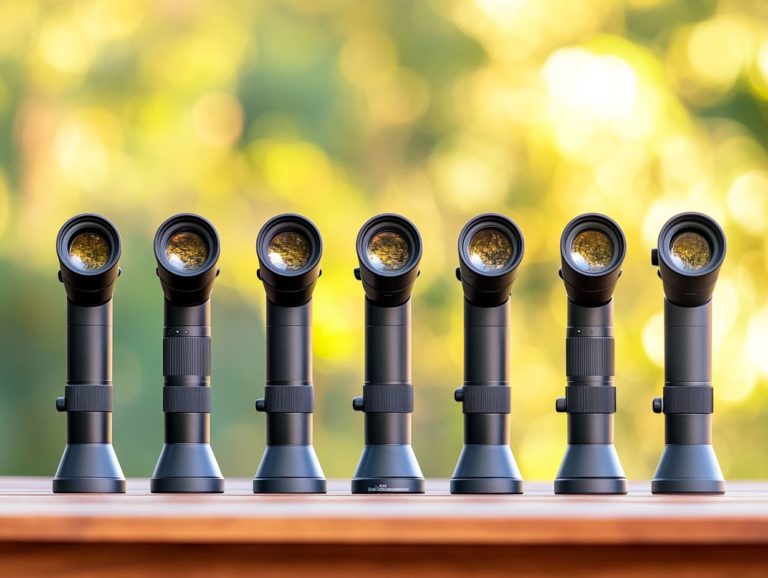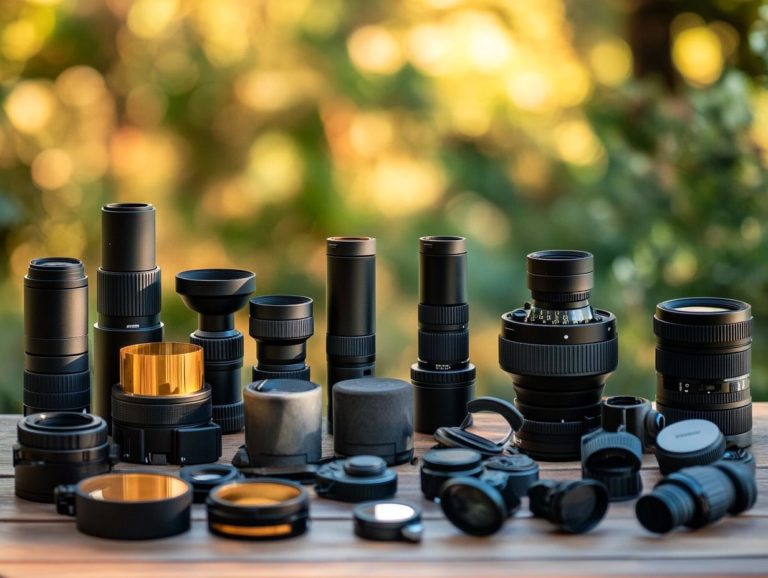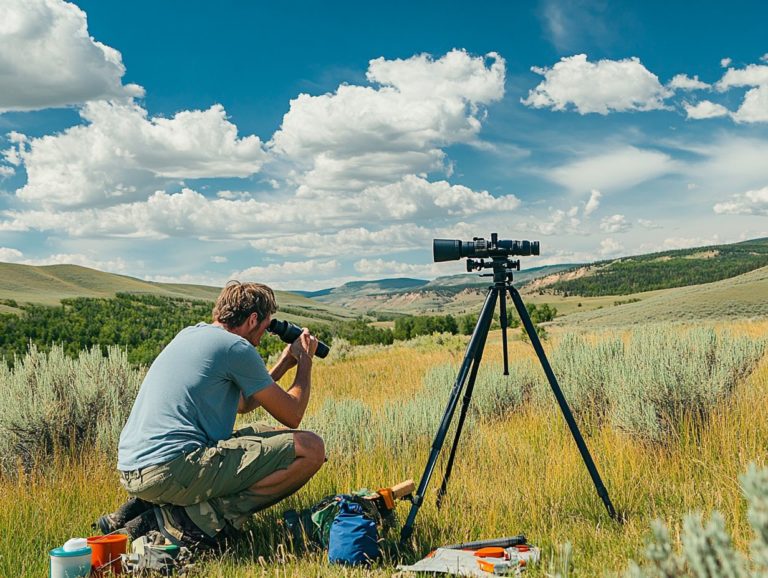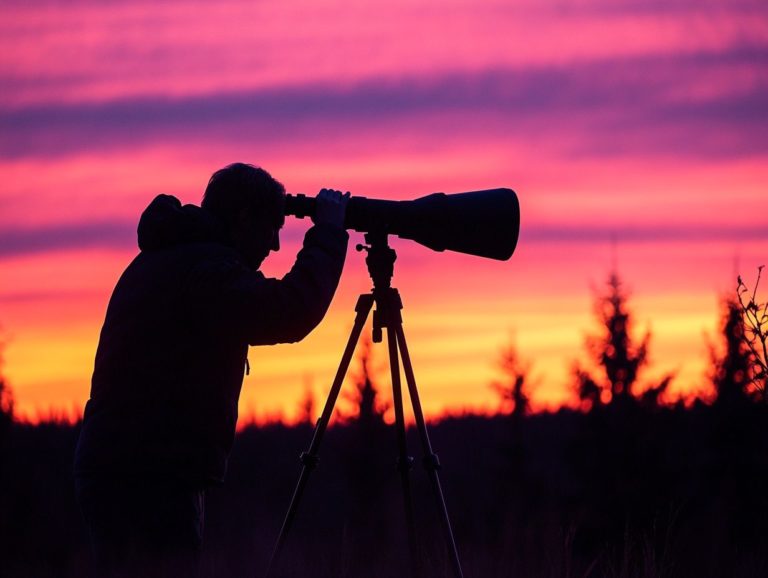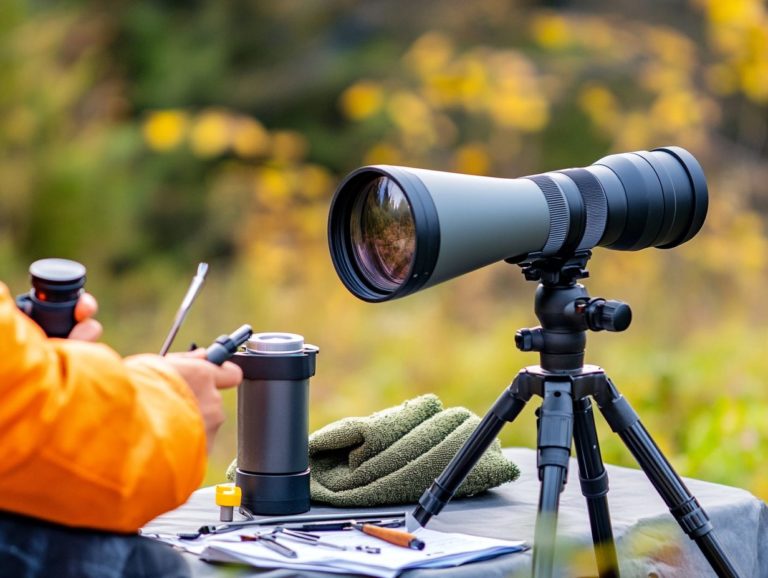Understanding Exit Pupil in Spotting Scopes
Spotting scopes can transform your viewing experience! Understanding the concept of exit pupil is essential for enhancing your viewing enjoyment.
This guide will illuminate what exit pupil is, why it matters, and how it affects the clarity and brightness of the images you see. You ll learn how to calculate exit pupil and discover various factors that influence it.
Whether you re a seasoned pro or just beginning your journey, grasping these elements will elevate your outdoor adventures to new heights!
Contents
- Key Takeaways:
- Importance of Exit Pupil in Spotting Scopes
- Calculating Exit Pupil
- Factors Affecting Exit Pupil
- Choosing the Right Exit Pupil for Your Needs
- Frequently Asked Questions
- What is exit pupil in spotting scopes and why is it important?
- How do I calculate the exit pupil of a spotting scope?
- Is a larger exit pupil always better?
- Can I adjust the exit pupil of a spotting scope?
- How does the exit pupil affect image brightness in spotting scopes?
- What is the ideal exit pupil for different activities?
Key Takeaways:
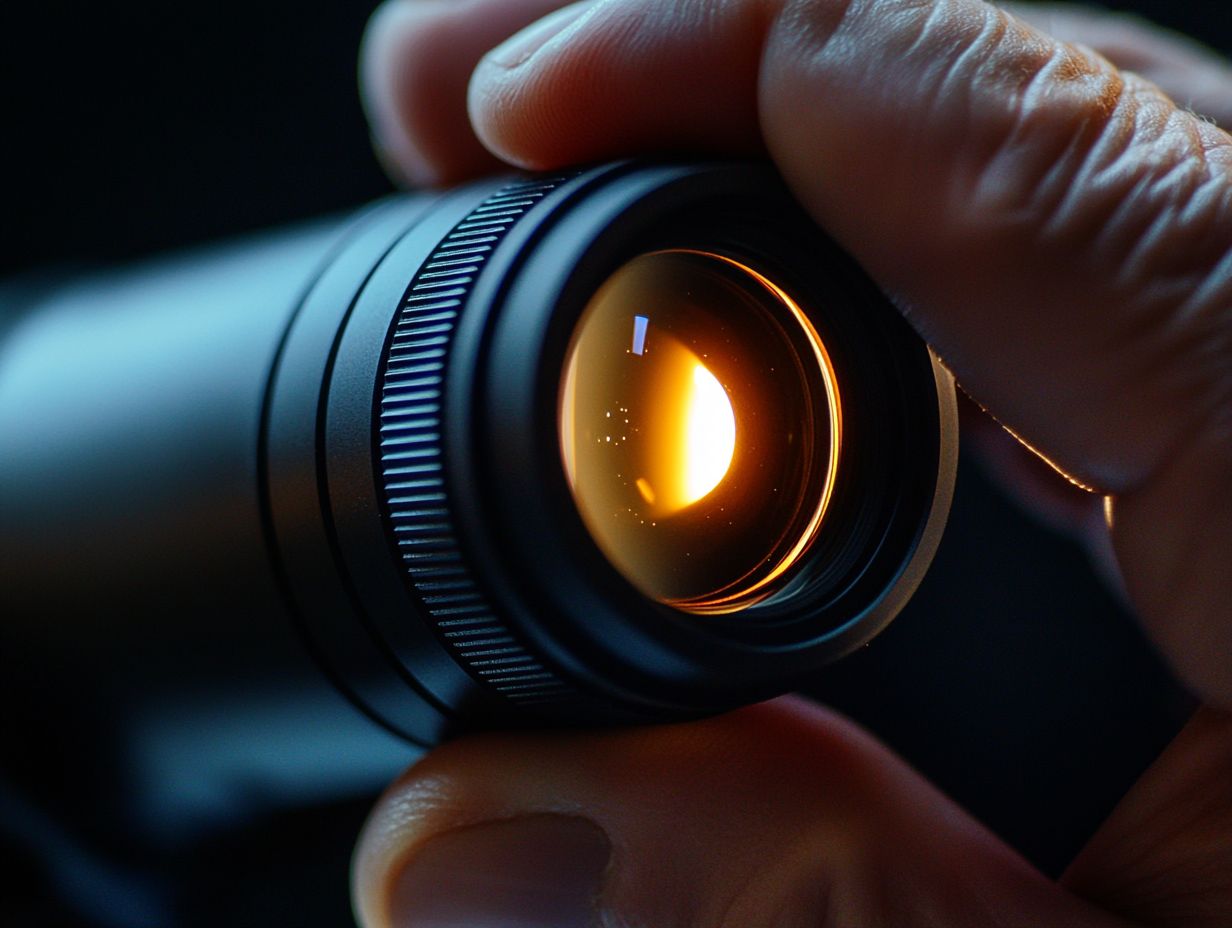
What is Exit Pupil?
The exit pupil is a crucial optical measurement that signifies the diameter of the light beam exiting an optical instrument whether it’s binoculars or telescopes that your eye can effectively use for clear visual observation.
Grasping this concept is essential if you’re looking into astronomical observation, photography, or utilizing spotting scopes and binoculars. It directly influences how light is transmitted and perceived in various lighting conditions.
A larger exit pupil can significantly enhance image brightness and contrast, particularly in low-light situations, while a smaller exit pupil might limit the intricate details you can observe.
Exit pupil greatly impacts your overall experience during both daytime and nighttime usage. For instance, when you’re aiming to achieve the highest level of zoom with a telescope eyepiece, ensuring a compatible exit pupil is vital for maintaining optimal brightness levels.
The general guideline suggests that to maximize visibility under average night conditions, the exit pupil should ideally match the diameter of your eye’s pupil, which is typically around 7mm. Meanwhile, during the day, a smaller exit pupil can be advantageous, enhancing detail without overwhelming your eye and ultimately improving comfort and clarity during extended observations.
Importance of Exit Pupil in Spotting Scopes
The significance of exit pupil in spotting scopes is paramount, as it fundamentally influences image brightness and clarity, greatly enhancing your observational experience! For those interested in birdwatching, understanding field of view in spotting scopes can help you appreciate how spotting scopes with a larger exit pupil can markedly improve visibility of deep-sky objects.
Those designed for higher magnification require careful attention to exit pupil size to achieve optimal performance in varying light conditions. This consideration becomes especially crucial during low-light or nighttime observations, when your eye s maximum pupil size can better engage with the light transmitted through the optical system.
How Exit Pupil Affects Viewing Experience
The exit pupil plays a pivotal role in shaping your viewing experience, as it directly influences the brightness levels and overall clarity of the images you perceive through telescopes or binoculars. Understanding how the exit pupil diameter affects maximum contrast is crucial, especially for visual astronomers like you who seek to explore deep-sky objects or intricate lunar details.
For instance, using a telescope with an exit pupil that aligns with your maximum pupil size during nighttime observations can significantly enhance the quality of what you see and deepen your field of view, allowing you to appreciate finer details in the universe.
This fact is vital since your pupil can dilate up to 7mm in darkness, enabling you to capture more light when the exit pupil also measures around this size. By understanding how to optimize exit pupil, you can enjoy a more effective viewing experience!
For example, pairing a low-power eyepiece with a wider exit pupil can reveal the subtle colors of nebulae while retaining essential details. By applying this knowledge during your observations, you can elevate your enjoyment and understanding of celestial phenomena, capturing the stunning beauty of the cosmos more vividly!
Calculating Exit Pupil
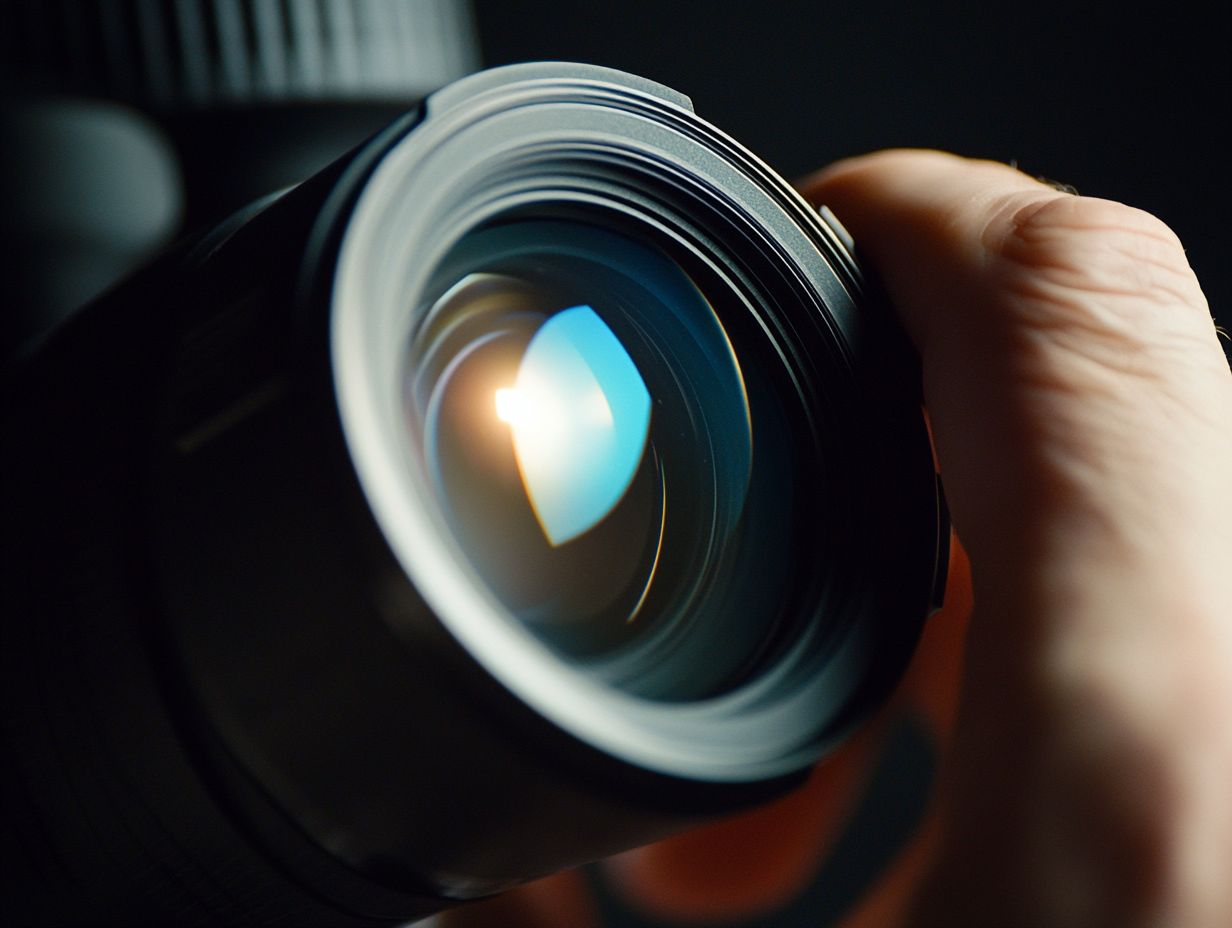
Calculating the exit pupil is a simple yet essential process that requires just a straightforward formula: divide the telescope’s the opening that allows light into the telescope by its magnification.
This calculation enables you to ascertain the amount of light exiting through the eyepiece, which directly influences image brightness and overall viewing quality.
For example, when you pair a specific focal length eyepiece (the part you look through to see through the telescope) with high magnification, you may end up with a smaller exit pupil. This scenario might not be the best choice for low-light conditions or for enhancing your observing experience, especially when gazing at deep sky objects.
Formula and Examples
The formula for calculating the exit pupil is elegantly simple: you divide the telescope aperture (in millimeters) by the magnification you re using. For instance, if you re working with a telescope featuring a 100mm aperture at 50x magnification, the exit pupil would be 2mm perfectly matching the maximum size of the human pupil in bright light.
By applying this formula, you can easily determine if your chosen magnification will provide an optimal viewing experience under various observing conditions.
Consider this: with a 200mm aperture and 100x magnification, the exit pupil also calculates to 2mm. However, if you ramp up the magnification to 200x, the exit pupil shrinks to just 1mm. This reduction could limit your ability to perceive light and contrast, particularly in low-light situations.
A larger exit pupil, say 5mm, is often ideal for stargazing! It allows for enhanced brightness and improved contrast, making celestial objects appear more striking. Curious about how to elevate your stargazing experience? By understanding how to adjust these parameters, you can significantly enhance your observations, especially during nighttime excursions or in dimly lit environments.
Factors Affecting Exit Pupil
Several factors influence the exit pupil, playing a crucial role in your ability to observe through optical systems like telescopes and binoculars. These factors encompass lighting conditions, your experience as an observer, and the specific design characteristics of the optical system you re utilizing.
Changes in light exposure, particularly when transitioning between daytime and nighttime use, can dramatically affect the exit pupil’s effectiveness. This ultimately impacts how well you can see celestial bodies and deep sky objects.
How Different Factors Impact Exit Pupil
Various factors can significantly influence the exit pupil, shaping your overall viewing experience through optical instruments. For example, in low light conditions, a larger exit pupil allows more light to enter your eye, enhancing brightness perception and enabling you to catch finer details in deep sky objects.
During the day, using the maximum power of a telescope may result in a smaller exit pupil, complicating observations in bright conditions and potentially sacrificing image clarity.
Your experience as an observer can greatly affect how effectively you utilize different eyepiece designs. Familiarity with various types allows for a more nuanced understanding of how exit pupil size impacts image quality.
While novice users might struggle to find the optimal settings for maximum contrast and brightness, seasoned astronomers can adeptly navigate these variables.
For instance, opting for an eyepiece tailored to specific light conditions can dramatically alter your viewing experience. Thus, it s essential to consider both your environment and your equipment as you aim to maximize the benefits of your telescope’s eyepiece.
Choosing the Right Exit Pupil for Your Needs
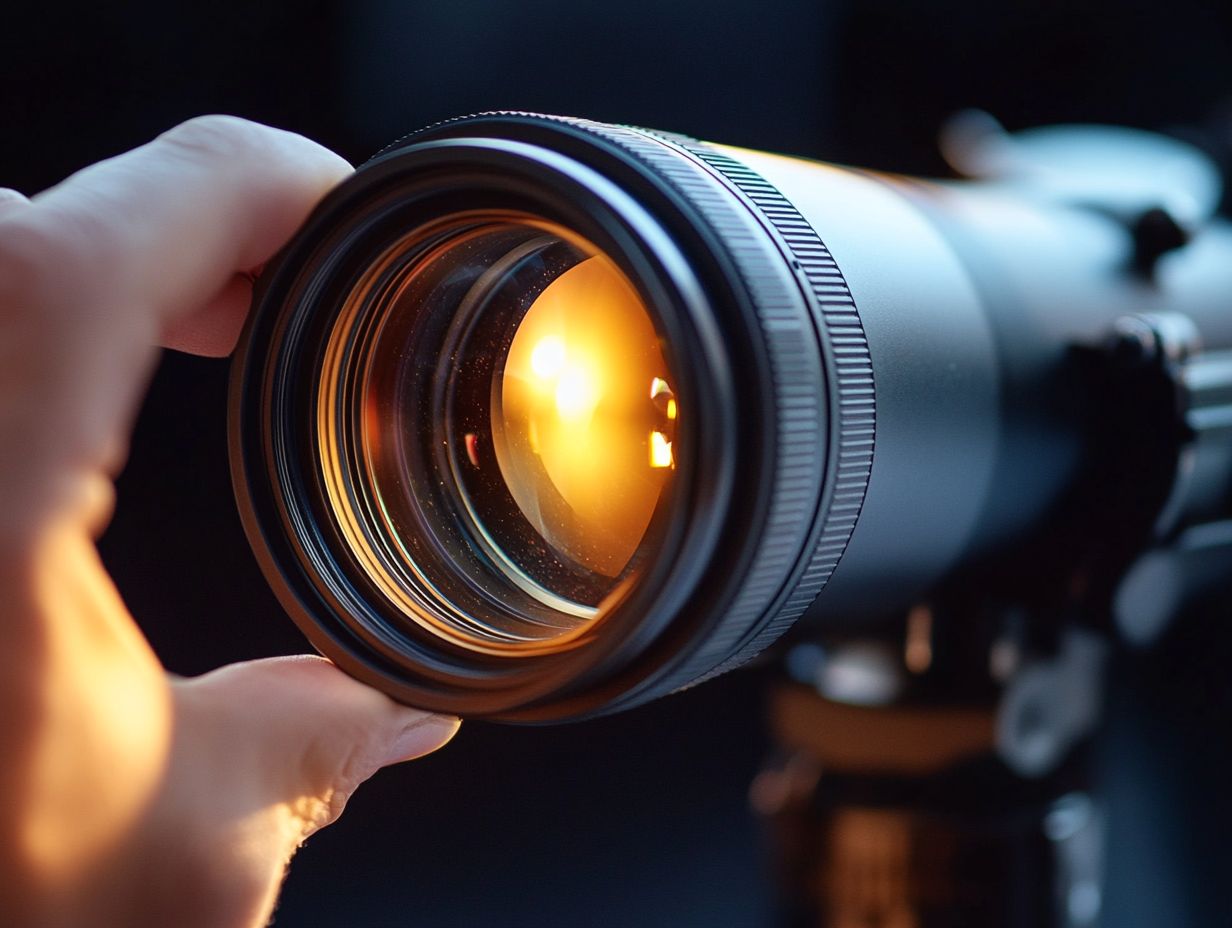
Selecting the appropriate exit pupil for your needs is crucial for enhancing your observational experience with various optical instruments, including binoculars and telescopes. A thoughtfully chosen exit pupil size guarantees optimal brightness and clarity during your observations!
Considerations such as the type of optical system, magnification effects, and specific observing conditions significantly influence the ideal exit pupil for your endeavors. Whether you’re exploring the night sky or navigating challenging light environments, don t miss out on the chance to see celestial wonders!
Considerations and Recommendations
When selecting the optimal exit pupil for your astronomical observations, there are several key considerations to enhance your experience. Understanding your viewing conditions is paramount. A larger exit pupil is typically favored in low-light scenarios, maximizing brightness and making faint celestial objects easier to spot.
You should also take into account the type of telescope you’re using. Different designs and magnification settings will significantly influence your visual experience.
If you re planning a deep-sky observation on a moonless night, a telescope eyepiece with a larger exit pupil is your best bet. It will allow you to see dim stars and galaxies with impressive clarity. On the flip side, for planetary observation, a smaller exit pupil can enhance contrast and reveal intricate details especially when the seeing conditions are just right.
Remember, your eyesight plays a crucial role in your stargazing adventure! If your pupils tend to dilate larger, a wider exit pupil may be beneficial. Conversely, if your pupils are smaller, a more compact size might suffice.
By customizing these factors to your specific observational techniques, you can truly elevate your stargazing experience.
Frequently Asked Questions
What is exit pupil in spotting scopes and why is it important?
Exit pupil refers to the virtual aperture created by the eyepiece of a spotting scope. It is important because it determines the amount of light that reaches your eye, resulting in a brighter and clearer image.
How do I calculate the exit pupil of a spotting scope?
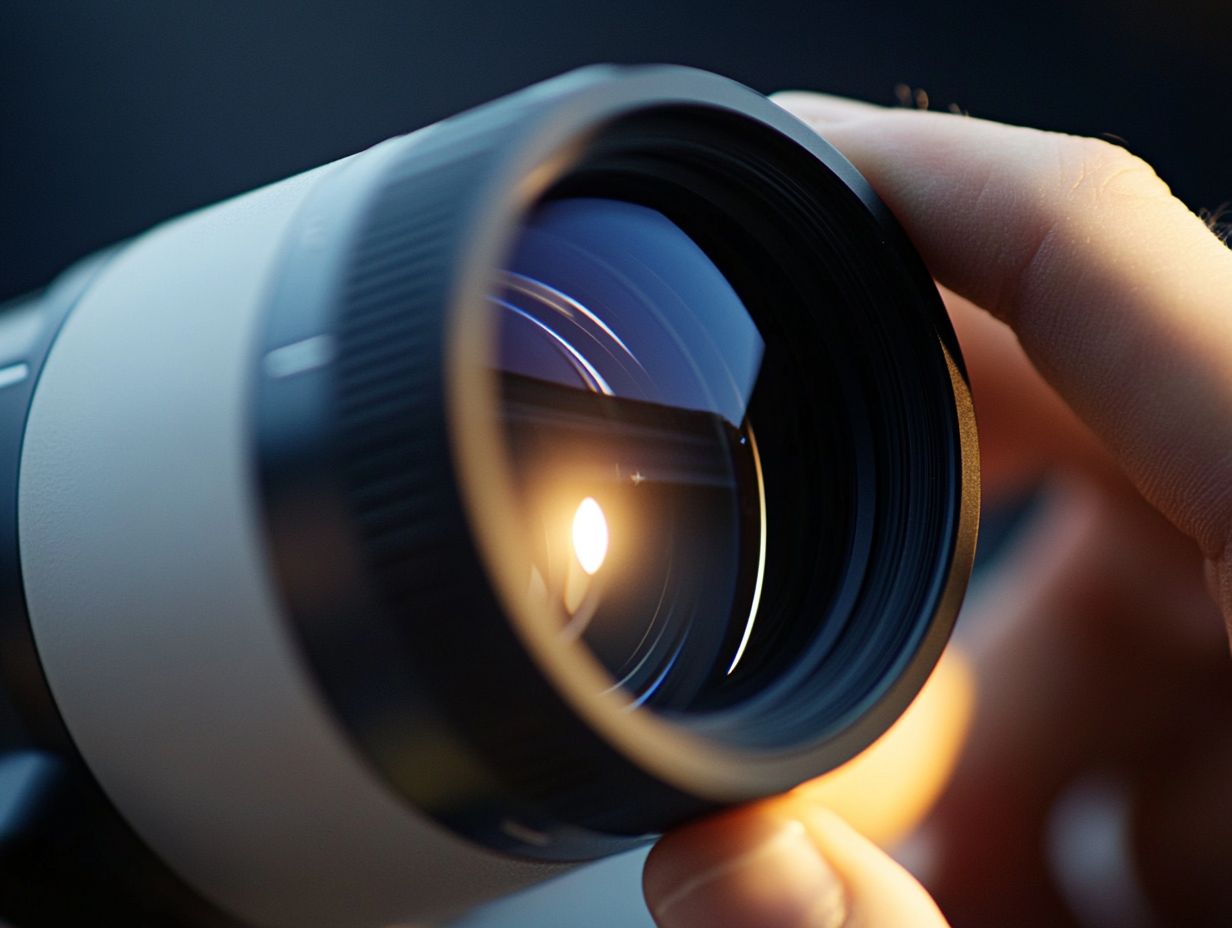
To calculate the exit pupil, divide the objective lens diameter by the magnification. For example, if a spotting scope has a 60mm objective lens and a magnification of 20x, the exit pupil would be 3mm.
Is a larger exit pupil always better?
Not necessarily. The ideal exit pupil size is around 5-7mm for most individuals, as our pupils typically dilate to around 7mm in low light conditions. However, a larger exit pupil can be beneficial for individuals with larger pupils or in extremely low light situations.
Can I adjust the exit pupil of a spotting scope?
No, the exit pupil is a fixed feature of a spotting scope and cannot be adjusted. However, you can choose a spotting scope with a larger or smaller exit pupil by selecting a different magnification or objective lens size.
How does the exit pupil affect image brightness in spotting scopes?
The exit pupil plays a crucial role in image brightness. A larger exit pupil allows more light to reach your eye, resulting in a brighter image. On the other hand, a smaller exit pupil may limit the amount of light and result in a dimmer image.
What is the ideal exit pupil for different activities?
The ideal exit pupil may vary depending on the activity. For bird watching or daytime use, a larger exit pupil (5-7mm) is recommended for brighter images. For stargazing or low light situations, a smaller exit pupil (3-5mm) may be more suitable to maintain image clarity.
Explore your local stargazing opportunities and share your experiences with fellow enthusiasts!

